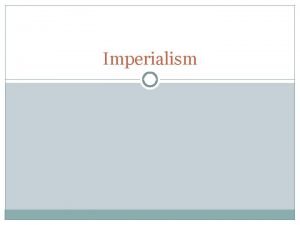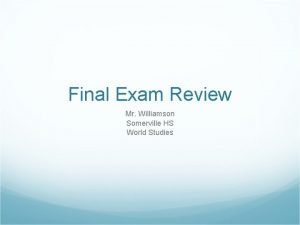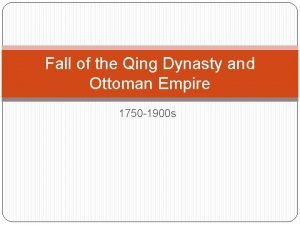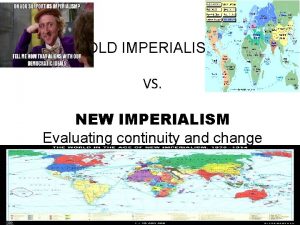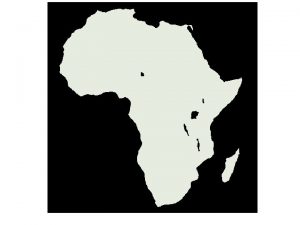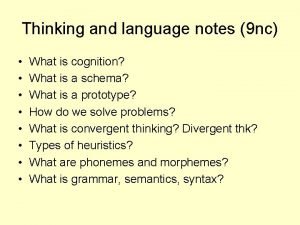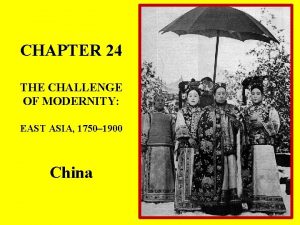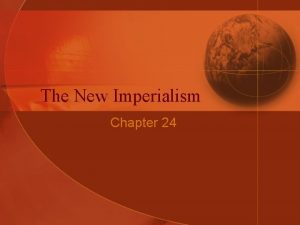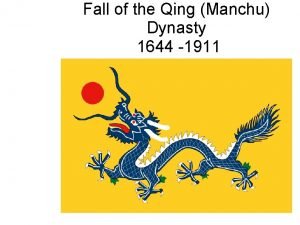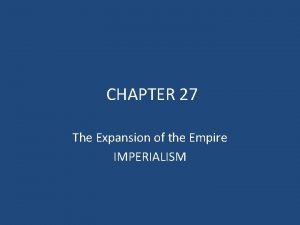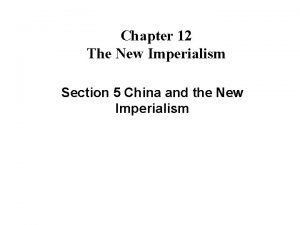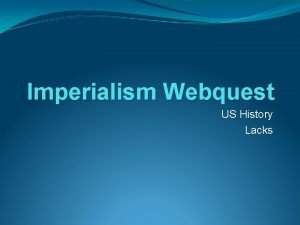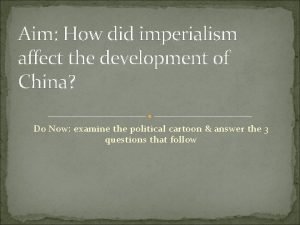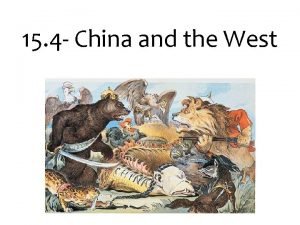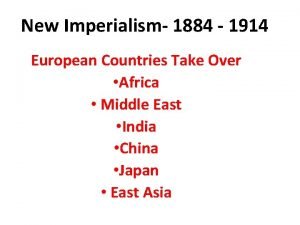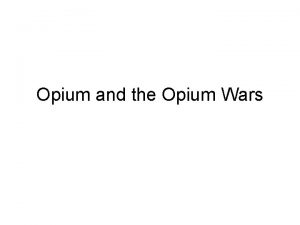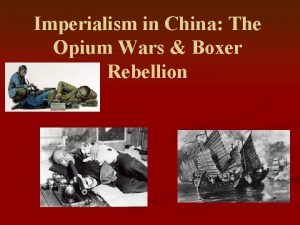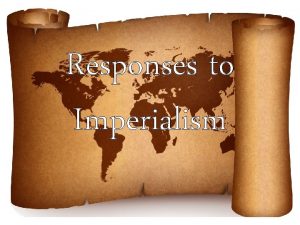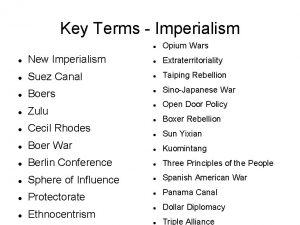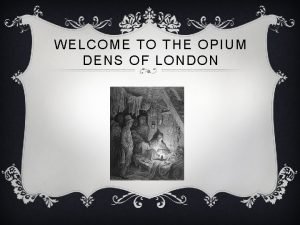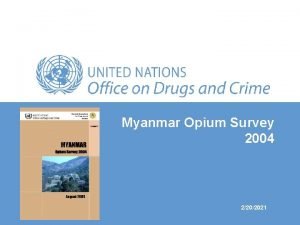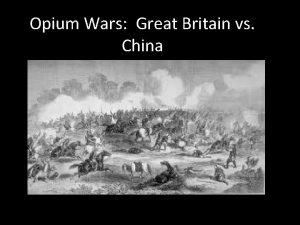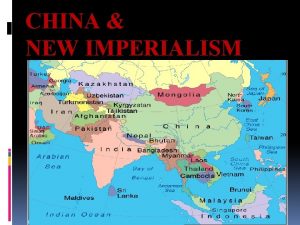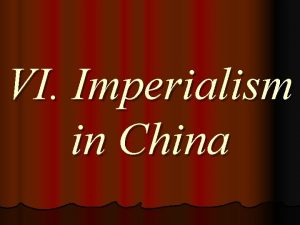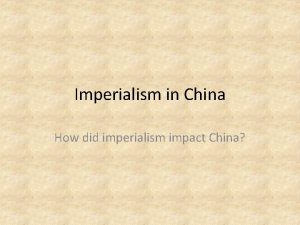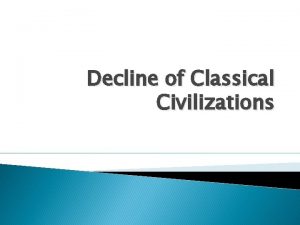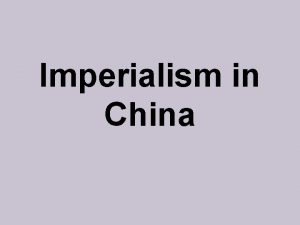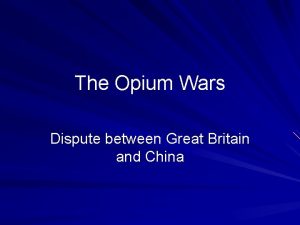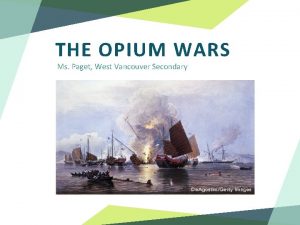China And Imperialism Decline After the Opium Wars






















- Slides: 22

China And Imperialism: Decline After the Opium Wars CHY 4 U Unit 3, May 2020

Themes • The rise of Japan (it had modernized, westernized and imperialized as part of the Meiji Restoration). • The unstable nature of China’s internal situation from 1830 s to 1920 s. • How China was victimized by imperialism and foreign presence. • Western influences on China from 1830 s to 1920 s. • Events in the early days set the stage for later civil war (1930 s). [think class conflict]

How did Japan, a country once closed off from the world since 1639, grow to become an imperial power? Booth, Anne. “Did it Really Help to be a Japanese Colony? East Asian Economic Performance in Historical Perspective”. Asia. Pacific Journal. May 2, 2007. Accessed April 4, 2016. http: //apjjf. org/-Anne-Booth/2418/article. html

Perry’s Arrival • In 1853 Commodore Matthew Perry of the US Navy arrived (armed) off the coast of Japan to press Japan to open trade – US was interested in coal and whale oil – US was a rising power itself at the time • This triggered a debate in Japan on whether to give in to the demands or not – Ultimately, Japan negotiated an agreement and was opened for trade “True portrait of Commodore Perry, envoy of the Republic of North America. ” Mortensen, Joan E. The Case for Commodore Perry in the Classroom. University of Texas at Dallas. 2008. Accessed April 4, 2016. http: //worldhistoryconnected. press. illinois. edu/4. 2/mortensen. html

Meiji Restoration • With Japan now open for trade, there was a movement to reform the entire country and to be able to ward off other situations like Perry – The Meiji Restoration of 1868 saw the return of power to the emperor and began a process of transformation: • • Modernization and westernization Industrialization Centralization of gov’t Imperialism 1889, Meiji Emperor reads the new constitution Editors of Encyclopedia Britannica, Meiji Restoration, March 19, 2020, https: //www. britannica. com/event/Meiji-Restoration.

Type of Reform Centraliz a-tion Restoration of the Emperor’s Power Modernization Military • One army • Navy • Compulsory military service for men Political • Centralized government with authority in emperor • Civil service created • Constitution modelled after Germany Economic • Banking, railroads, ports, telegraphs, postal system, industrialization in shipyards, copper, coal, steel Social • Compulsory education for boys and girls • Western Dress


Japan’s Growing Military Might • 1894 – Sino-Japanese War – An easy win for Japan over the issue of Korea – The 1895 Treaty of Shimoneseki ceded the island of Formosa (Taiwan) and the Liaotung Peninsula in the north to Japan • 1904 -1905 – Russo-Japanese War – In under two years this new imperial power defeated Russia, an old imperial power – Korea became an official ‘protectorate’ of Japan, though there was nothing protective about the harsh way Japan treated Korea and Koreans Map of the Russo-Japanese War with a chronological sequence of major events. June 10, 1904 The Hawaiian Gazette Library of Congress, Russo-Japanese War: Topics in Chronicling America, Nd. , Accessed May 13, 2020, https: //guides. loc. gov/chronicling-america-russo-japanese-war.

What Does This 1898 French Cartoon Tell Us About China and the World? Chinese government official (note his portrayal) France and Russia Germany and Britain Japanese Samurai (in reality they were out of power)

Boxer Poster, 1900 “On account of the Protestant and Catholic religions the Buddhist gods are oppressed, and the [Confucian] sages thrust into the background. The law of Buddha is no longer respected, and the five Relationships [of Confucian ethics] are disregarded. The anger of Heaven and Earth has been aroused and the timely rain has consequently been withheld from us. But Heaven is now sending down eight million spiritual soldiers to extirpate these foreign religions, and when this has been done there will be timely rain. ” Boxer pronouncement, 1900 quoted in Joseph Esherick, The Origins of the Boxer Uprising (Berkeley: University of California press, 1987), 282.

Historical Interpretation of the Boxers “They were mostly adolescent gangs who attacked Christian converts, missionaries, and churches. Rising out of drought conditions and anti-foreign feeling in northern China, these socalled Boxers were ragtag groups that terrorized local communities from 1898 to 1900. Had the government been strong and prosperous, as it had been a century and a half earlier, it most certainly could have suppressed them. But China was weak and close to bankruptcy after more than half a century of wars against outside aggressors (Great Britain, France, and Japan) and decades of trying to put down internal rebellions. China was also limited by its status as a semi-colony after Western powers forced a “treaty system” upon it in the midnineteenth century – a system that gave various economic and political rights and privileges to Westerners and in the process cut back on Chinese rights. ” R. Keith Schoppa, Twentieth Century China: A History in Documents (New York: Oxford University Press, 2011), 9.

Foreign Intervention in the Boxer Rebellion 19 000 foreign troops enter Beijing to put down the uprising and protect their interests in China.

1905 Cartoon in a Chinese Journal: “National Humiliation Picture” “The Chinese carries a flag proclaiming his readiness to submit to foreign occupation, but the foreign soldier is nevertheless ready to slash the Chinese to death. ”

End of Empire • Last Chinese Dynasty – Qing (1644 -1911) • Manchus from the northeast, not Han Chinese • Overthrown in 1911, beginning the Republic of China Cixi, Dowager Empress Amanda Bensen, Cixi: The Woman Behind the Throne, Smithsonian Magazine, March 1, 2008, http: //www. smithsonianmag. com/histor y-archaeology/dacixi. html? c=y&page=2 (Dec. 17, 2013).

REPUBLIC / CIVIL WAR Though the late empire had made some efforts to change and reform, there was pressing demand to get rid of the empire itself, especially in southern China and amongst Chinese abroad. The result was the 1911 revolution that ushered in the Republic era. Revolutionaries in Shanghai Qing soldiers Sun Yat-Sen US State Department, Office of the Historian, Bureau of Public Affairs, The Chinese Revolution, 1911, N. d. , https: //history. state. gov/milestones/1899 -1913/chinese-rev (May 25, 2016)

The Hard Part is After the Revolution Just because China had a new form of government (_______ instead of _______) this doesn’t mean its problems disappeared. • Which problems were old? (continuities) • Which problems were new? (changes)

Japanese Demands, 1915 “Group 1: – The Japanese Government and the Chinese Government being desirous of maintaining the general peace in Eastern Asia and further strengthening the friendly relations and good neighborhood existing between the two nations agree to the following articles: • Article 4: The Chinese Government engages, in interest of trade and for the residence of foreigners, to open by herself as soon as possible certain important cities and towns in the Province of Shantung as Commercial Ports. What places shall be opened are to be jointly decided upon in a separate agreement. ” R. Keith Schoppa, Twentieth Century China: A History in Documents (New York: Oxford University Press, 2011), 34.

“Group 2 – The Japanese Government and the Chinese Government, since the Chinese Government has always acknowledged the special position enjoyed by Japan in South Manchuria and Eastern Inner Mongolia, agree to the following articles: • Article 7: The Chinese Government agrees that the control and management of the Kirin-Changchun Railway shall be handed over to the Japanese Government for a term of ninety-nine years dating from the signing of this agreement. ” Ibid. , 34 -35.

• “Group 5 – Article 1: The Chinese Central Government shall employ influential Japanese as advisers in political, financial, and military affairs. – Article 2: Japanese hospitals, churches, and schools in the interior of China shall be granted the right of owning land. – Article 3: Inasmuch as the Japanese Government and the Chinese Government have had many cases of disputes between Japanese and Chinese police which caused no little misunderstanding, it is for this reason necessary that the police departments of important places (in China) shall be jointly administered by Japanese and Chinese…. ” Ibid. , 36, 37. Full text of all 21 demands, translated, can be found at https: //china. usc. edu/japanese-

• Yuan Shikai agreed to the demands in groups 1 to 4. Group 5 was to be negotiated later. • Agreement took place on May 8, 1915, often referred to as National Humiliation Day. • Can you see why? • Was this a strong start to the Republic? Ibid. , 34; Encyclopaedia Britannica Online, Yuan Shikai, N. d. , http: //www. britannica. com/EBchecked/media/149356/Yuan-Shikai-asemperor-of-China-1915 -16 (Dec. 17, 2013). Check out this blog post for an interesting read on the demands: https: //www. cfr. org/blog/china-japan -and-twenty-one-demands Yuan Shikai

Conclusion • On the whole, these ______ demands show that _______saw China as ___________________.

 Opium wars and boxer rebellion
Opium wars and boxer rebellion Opium wars defintion
Opium wars defintion Open door policy defintion
Open door policy defintion Why did britain begin exporting opium to china?
Why did britain begin exporting opium to china? The rise and fall of qing dynasty
The rise and fall of qing dynasty New imperialism vs old imperialism
New imperialism vs old imperialism After me after me after me
After me after me after me If any man will come after me
If any man will come after me Old imperialism vs new imperialism
Old imperialism vs new imperialism Chapter 9 thinking and language notes
Chapter 9 thinking and language notes Moscontin 30 mg en arabe
Moscontin 30 mg en arabe Ergotyl sol kapi
Ergotyl sol kapi Opium adalah
Opium adalah Opium chapter 24
Opium chapter 24 Chapter 24 section 5 china and the new imperialism
Chapter 24 section 5 china and the new imperialism Queue hair
Queue hair China and imperialism
China and imperialism Chapter 12 section 5 china and the new imperialism
Chapter 12 section 5 china and the new imperialism Rome after the punic wars
Rome after the punic wars Imperialism in china webquest answers
Imperialism in china webquest answers China imperialism cartoon
China imperialism cartoon Western imperialism in china
Western imperialism in china Imperialize synonym
Imperialize synonym


